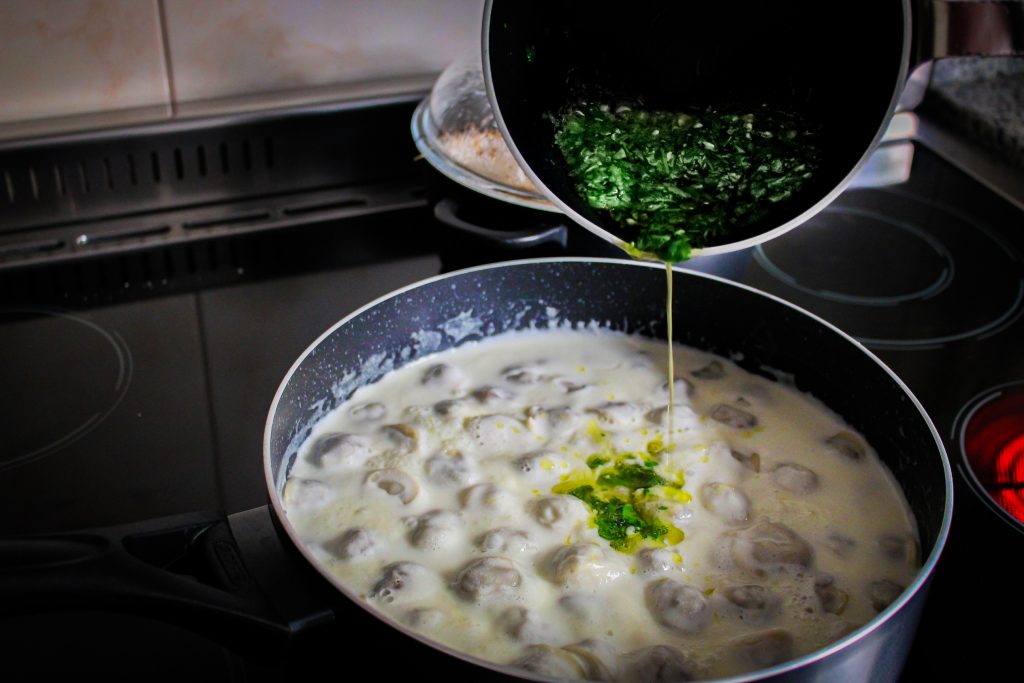These little meat-filled dumplings simmered in a tangy yogurt sauce are true comfort food. In our family, Shishbarak is always a dish for special occasions—because of how much love and time it takes. It’s the kind of recipe that fills the kitchen with warmth, garlic, and the smell of dough baking in the oven.
There’s plenty of debate over where Shishbarak originated, and every country across the region seems to have its own version and name for it. But what’s consistent is how long it’s been around—and how beloved it continues to be.
Why I Make It From Scratch
These days, a lot of people opt for pre-made frozen Shishbarak, but I think that’s such a shame. I know it can seem like a tricky or intimidating dish to make at home, but I promise it’s not. Yes, it takes some time, but every step is doable and deeply rewarding. Personally, I find working with dough incredibly therapeutic, and the process of shaping each dumpling is almost meditative.
Once you get the rhythm of filling, folding, and pinching, it actually becomes quite fun. And making a big batch? That just means you can freeze extras for a later cozy dinner.
If you enjoy comfort food like this, you might also love my recipe for Eggplant Fatteh

The Dough
The dough is as simple as it gets: flour, water, salt, and a splash of oil. I usually use ¾ cup of water for 2 cups of flour, but this depends on your climate. I live in a hot and dry area, so you might need to adjust slightly depending on your humidity. Adding the oil toward the end of kneading keeps the dough moist and easy to roll.
Roll it out to about 2mm thickness—not too thin so it doesn’t tear, but not too thick that it turns chewy after baking.
The Filling
There are two schools of thought when it comes to the meat: raw vs. cooked. Some people use raw meat, but we always cook the filling first, which I prefer.
Let the meat filling cool completely before you start filling the dough rounds.
Shaping the Dumplings
I use a 5cm cookie cutter to shape the circles. Some people go smaller, others larger, but I think this is the perfect size for the right meat-to-dough ratio.
To shape:
-
Place a small amount of filling in the center of the dough circle.
-
Fold it in half to make a crescent and press to seal.
-
Fold the two ends of the crescent around each other to form a tortellini shape.
You’ll get about 90 dumplings from this batch.
Bake First, Then Freeze (or Cook)
Before going into the yogurt sauce, the dumplings are briefly baked—just enough to firm them up. This helps them hold their shape in the sauce and allows you to freeze them if you’re prepping ahead.
We usually bake them for just 7 minutes, not until browned.
To freeze: lay them out on a tray until solid, then transfer to a freezer bag. They’ll keep for 3 months.
Cooking the Yogurt Sauce
The yogurt sauce is what brings everything together—but I know it can be intimidating. There are a lot of “tricks” out there, but I follow a simple, foolproof method I learned from a chef in my uncle’s restaurant in Damascus: stir consistently and add a little cooking cream.
Here’s the key: never stop whisking the yogurt until it starts to simmer, or it will split.
Don’t Skip the T’layeh
The final touch is a drizzle of sautéed garlic and fresh coriander—what we call t’layeh. It’s not just a garnish. It adds incredible depth and is essential for the full flavor of the dish. You’ll find it in many Syrian recipes for good reason.
Serve It Right
Shishbarak is best served hot with vermicelli rice on the side or more traditionally, on it own. It’s rich, tangy, and deeply comforting—the kind of dish that transports you with every bite.
IF YOU TRY THIS RECIPE AND ENJOY IT, PLEASE LEAVE A RATING AND A COMMENT BELOW. YOU CAN ALSO TAG ME ON INSTAGRAM. I WOULD LOVE TO SEE YOUR CREATIONS.

Shishbarak (Meat Dumplings in Yogurt Sauce)
Equipment
- 5 cm cookie cutter
Ingredients
For the filling
- 300 g ground beef
- 1 small onion finely chopped
- ½ tsp Salma’s spice
- 1 tsp salt
- 1 tbsp vegetable oil for cooking
For the dough
- 2 cups flour
- ¾ cup water
- 1 tsp salt
- 1 tbsp vegetable oil
For the yogurt sauce
- 1 kg yogurt
- 2 tbsp corn starch (dissolved in 100 ml water)
- ¼ cup cooking cream
T’layeh (final touch)
- 1 tbsp ghee (or butter or vegetable oil)
- 3 tbsp chopped coriander
- 2 cloves garlic minced
Instructions
Filling
- Heat oil and sauté onion until soft. Add meat, salt, and Salma’s spice. Cook until no liquid remains. Let cool completely.
Dough
- Combine flour and salt. Gradually add water while kneading until a smooth, soft dough forms. Add oil and knead again. Rest for 15–20 minutes.
- Roll dough to 2mm thickness and cut circles using a 5 cm cutter. Place ½ tsp filling in the center. Fold into a crescent and pinch to seal. Bring ends together to form tortellini shapes. Repeat.
- Place dumplings on a tray and bake at 180°C (355 F) for 7 minutes. Let cool or freeze if desired.
Yogurt sauce
- Whisk yogurt and corn starch mixture until smooth. Heat over medium, whisking constantly, until it simmers. Add cooking cream and stir to combine.
- Gently place dumplings into the sauce. Do not stir until the dumplings are fully booked. Cook for 10–12 minutes or until soft and fully cooked.
- Heat ghee and sauté garlic and coriander for 1–2 minutes. Add to the yogurt just before serving.
- Spoon into bowls and serve with vermicelli rice.








